k0rbi3
3 Reasons You May Not Be Building Muscle
3 Reasons You May Not Be Building Muscle
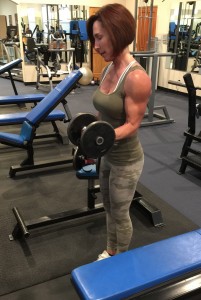 Are you one of those people that has been investing long hours in the gym for what seems like very little return on your investment? Well, you are not alone. Most people have a hard time understanding the concept of building muscle and therefore struggle to build muscle. They follow the more is better mentality and do set after set of endless exercises to mimic what their fitness idols in the magazines are doing. What they fail to realize is that their fitness idol in the magazine may not necessarily be doing the workout that was printed, or that their fitness idol may be using substances that increase their muscle recovery ability. If you are one of those people that are frustrated with the subpar results you have been getting from your workouts, read on to find out if you’ve been making one of these mistakes.
Are you one of those people that has been investing long hours in the gym for what seems like very little return on your investment? Well, you are not alone. Most people have a hard time understanding the concept of building muscle and therefore struggle to build muscle. They follow the more is better mentality and do set after set of endless exercises to mimic what their fitness idols in the magazines are doing. What they fail to realize is that their fitness idol in the magazine may not necessarily be doing the workout that was printed, or that their fitness idol may be using substances that increase their muscle recovery ability. If you are one of those people that are frustrated with the subpar results you have been getting from your workouts, read on to find out if you’ve been making one of these mistakes.
- Training too Many Days in A Row.
Fail to see the gains when you over-train! We are a society with a “more is better” attitude. More time, more money, more luxury, more, more, more! However, when aiming to build MORE muscle, one of the reasons athletes fail to build the physique they desire is too much time in the gym! When scheduling my personal training clients, I often hear, “I want to work out 4 or 5 times a week.” It is then I begin to explain that every time we train, we are breaking down muscle fibers, which then need time to recover, rebuild, and grow. Training too many days in a row does not give the body time to repair the micro trauma that occurs within muscles during training. This is not only applicable to our muscles, but our central nervous system as well. The body must restore hormonal and neurotransmitter-balance, reboot the immune system, and clear free radicals from the body. Implement those rest days into your schedule!
- Extended Workouts!
The duration of your workouts should last no longer than 60-75 minutes. When I question my personal training clients about the duration of their workouts, I frequently hear, “I spend an 1.5 hours to 2 hours in the gym.” More is less in this case. There is scientific evidence that after 60 to 75 minutes of intense weight training, testosterone levels begin to diminish and cortisol levels begin to rise dramatically. Thus impeding the body from reaching a growth inducing state once the workout has ended. Furthermore, there is no reason any workout should surpass 75 minutes. If you are about building that muscle, get in the gym, do what you have to, and get out.
- Fail To Follow A Well Balanced Nutrition Plan!
Building muscle is more than just lifting and time spent in the gym. 50% of success depends on the nutrition aspect of your plan. With a well-balanced meal plan that incorporates protein, healthy fats, complex carbohydrates and fiber, you can expect to make serious gains and build lean muscle mass. The more serious your gains will be with dedication and discipline to a balanced nutrition plan. In fact, if you research literature on weightlifting, you’d quickly learn that both nutrition and proper training is imperative in reaching those fitness goals.
Spending too much time in the gym, not giving your muscles enough time to recover between workouts, and improper nutrition are three of the main reasons you may have reached a sticking point in your quest to build more muscle. However, due to our diverse fitness goals, an individualized plan that is created specifically for you and your body will ensure maximum results. For more information on obtaining an individualized plan to help you get maximum results, lose weight, build strength, or if you’re frustrated with your current level of fitness and looking to hire a personal trainer, contact us.
“SPOT REDUCTION”
“SPOT REDUCTION”
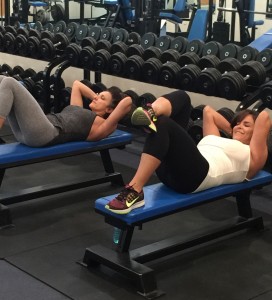 Many of my personal training clients have come to me and expressed that they want to lose a few extra pounds from certain areas of their bodies like their stomach, thighs, and arms, but would like to keep weight on other areas like their breast or their buttocks. Unfortunately, this way of thinking will lead to disappointment and little, if any, success. There is no such thing as spot reduction. When you lose body fat, you lose from the entire body. Your genetics determine which area of your body loses fat the easiest and which areas are the most stubborn.
Many of my personal training clients have come to me and expressed that they want to lose a few extra pounds from certain areas of their bodies like their stomach, thighs, and arms, but would like to keep weight on other areas like their breast or their buttocks. Unfortunately, this way of thinking will lead to disappointment and little, if any, success. There is no such thing as spot reduction. When you lose body fat, you lose from the entire body. Your genetics determine which area of your body loses fat the easiest and which areas are the most stubborn.
Our genetics are responsible for many things, how tall we are, the color of our eyes, the potential size of our muscles, the number of fat cells we’re born with, and where those fat cells are located. We’re all born with a certain number of fat cells. Our fat cells don’t multiply, they just expand when you follow an unhealthy diet. Then, if your fat cells have expanded and you change your eating habits and incorporate some exercise your fat cells shrink back down. Just like you can’t change the number of fat cells you’re born with, you can’t change where those fat cells are located.
So if you’re born with an abundance of fat cells on your stomach or your inner thighs and a lot less fat cells in other areas of your body, when you eat bad you’re going to notice the areas with the most fat cells. If you notice your belly or your triceps have gotten especially flabby compared to the rest of your body, just know that you were genetically predisposed to carry more fat cells in those particular areas. Now you can still lose the fat in those stubborn areas, but it’s just going to take longer because there are more cells to shrink. So if you have an area of the body that seems to be particularly stubborn to losing fat, just know you have to be patient.
Exercise, follow a healthy diet, and stay consistent. Set small attainable goals weekly and make sure you achieve them. Stay focussed! Don’t let anything or anyone get in the way of you achieving your goals.
For more information on weight loss, strength training, and eating healthy, or if you’re frustrated with your current level of fitness and looking to hire a personal trainer, contact us.
Can You Actually Eat Bread and Lose Weight?
Can You Actually Eat Bread and Lose Weight?
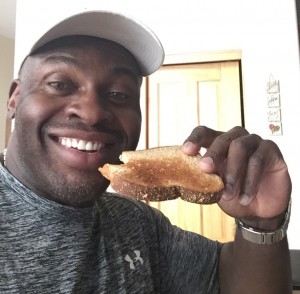 Recently Oprah has been in the news talking about how she has been able to eat bread every day and still lose weight. Is it really possible for someone to eat bread on a daily basis and lose weight? The answer is YES!!! Truth of the matter is: a carb is a carb. Therefore, whether you consume bread, rice cakes, or oatmeal, the body will convert every carbohydrate into its best usable source of energy, which is known as glucose. I could never understand why so many people cut bread out of their diets in pursuit of weight loss. I incorporate bread in many of my personal training clients’ diets with very successful results.
Recently Oprah has been in the news talking about how she has been able to eat bread every day and still lose weight. Is it really possible for someone to eat bread on a daily basis and lose weight? The answer is YES!!! Truth of the matter is: a carb is a carb. Therefore, whether you consume bread, rice cakes, or oatmeal, the body will convert every carbohydrate into its best usable source of energy, which is known as glucose. I could never understand why so many people cut bread out of their diets in pursuit of weight loss. I incorporate bread in many of my personal training clients’ diets with very successful results.
Carbohydrates are found in fruit, vegetables, grains (yes bread), and other starches. Carbohydrates are a main source of energy for the body; they can be metabolized fast or slow depending on your individual needs. Here’s how it works, during digestion carbs travel through the small intestine. They then get further broken down into single carbohydrate units known as monosaccharides. These single molecules get absorbed across the intestinal wall and are sent through the blood stream. Carbohydrates in the blood are in the form of a monosaccharide called glucose(blood sugar). That blood sugar can now be used for either slow or faster burning energy. For instance, during high intense, short exercise blood sugar can give energy to muscle cells through anaerobic(without oxygen) pathways. For longer duration, steady state cardio, blood sugar can be broken down through aerobic(with oxygen) pathways.
A diet that provides sufficient amounts of carbohydrates keeps your blood sugars steady and prevent your muscles from entering a catabolic state. Carbohydrates are an essential part of a healthy diet because your body converts them to glucose and your body runs on glucose. Some perfectly healthful foods such as carrots, potatoes, bread, and apples should be part of your balanced diet. Consuming such carbohydrates will fuel the body and provide you with the energy that is needed to get you through those intense workouts, which will in turn get those results that you are aiming for.
For more information on a well-balanced diet, consuming the right number of calories for your specific needs, getting in shape, and losing weight, contact us.
Exercise and Blood Pressure!
Exercise and Blood Pressure!
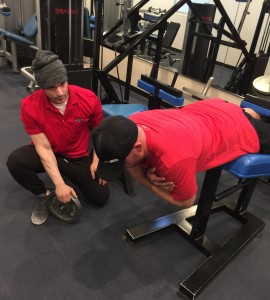 About 70 million American adults have high blood pressure—that’s 1 of every 3 adults. Only about half of people with high blood pressure have their condition under control and nearly 1 of 3 American adults has prehypertension—blood pressure numbers that are higher than normal, but not yet in the high blood pressure range. High blood pressure costs the nation $46 billion each year. This total includes the cost of health care services, medications to treat high blood pressure, and missed days of work. Follow these tips for a drug-free approach to prevent you from becoming one of these statistics.
About 70 million American adults have high blood pressure—that’s 1 of every 3 adults. Only about half of people with high blood pressure have their condition under control and nearly 1 of 3 American adults has prehypertension—blood pressure numbers that are higher than normal, but not yet in the high blood pressure range. High blood pressure costs the nation $46 billion each year. This total includes the cost of health care services, medications to treat high blood pressure, and missed days of work. Follow these tips for a drug-free approach to prevent you from becoming one of these statistics.
- Exercise- A strong heart pumps more blood with less effort. If your heart works less to pump, the force on your arteries decreases, resulting in a lower blood pressure. Becoming more active can lower your systolic blood pressure-the top number in a blood pressure reading. Regular exercise also helps you maintain a healthy weight, another important way to control blood pressure. It can take from one to three months of regular exercise to have an impact on your blood pressure. To keep your blood pressure low, you need to make exercise a healthy habit.
- Weight Training- Weightlifting can have long-term benefits on your blood pressure. The Department of Health and Human Services recommends incorporating strength-training exercises of all the major muscle groups into a fitness routine at least two times a week.
- Monitor Your Blood Pressure– The only way to detect high blood pressure is to monitor your blood pressure readings. Have your blood pressure checked at each doctor’s visit, or use a home blood pressure monitor. When checking your blood pressure, keep in mind that you’ll get the most accurate readings if you check your blood pressure before you exercise.
Research has found that regular exercise dramatically reduces systolic and diastolic blood pressure. Making exercise a part of your routine has been clearly proven to play an important role in prevention of hypertension. So what are you waiting for? We all strive for a healthier lifestyle. Do not become one of those statistics. Exercise and resistance training can benefit you in all aspects of your life. To learn more about lowering your blood pressure, exercise, strength training, staying in shape, or if you’ve been thinking about hiring a personal trainer, contact us.
Are You Consuming Enough Fiber in your Diet????
Are You Consuming Enough Fiber in your Diet????
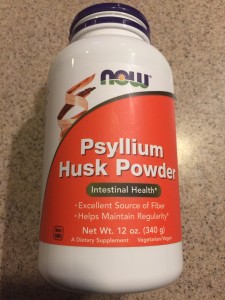 Do you consume enough fiber each day? If you are like most Americans, then you probably consume about 10 to 15 grams of fiber a day. Unfortunately, this is just not enough. The American Heart Association recommends between 25 and 38 grams of fiber a day in a well-balanced diet.
Do you consume enough fiber each day? If you are like most Americans, then you probably consume about 10 to 15 grams of fiber a day. Unfortunately, this is just not enough. The American Heart Association recommends between 25 and 38 grams of fiber a day in a well-balanced diet.
Lack of fiber may be detrimental to your health. Insufficient fiber can increase your risk of colon cancer, as well as increase the risk for diverticular disease. Elevated levels of total and LDL cholesterol in the blood can also be attributed to insufficient fiber. Fiber helps give you a feeling of fullness that prevents you from overeating.
What exactly is fiber?
Fiber is a plant material that cannot be digested but that helps you to digest other food. There are two types of fiber, soluble and insoluble.
Soluble fiber dissolves with water and creates a gel-like substance that helps to lower blood cholesterol and glucose levels.
Insoluble fiber absorbs water, which adds bulk to your digestive tract and helps to move things through quickly and promote regularity.
Foods Rich In Fiber
Selecting tasty foods that provide fiber isn’t difficult. Soluble fibers include oats, oat bran, peas, rice bran, legumes/beans, apples, and citrus fruits. Insoluble fibers include whole-wheat flour, wheat bran, rye, cabbage, carrots, brussel sprouts and nuts.
To find out more about how much dietary fiber you need, getting in shape, working out, or if you’re frustrated with your current level of fitness and looking to hire a personal trainer, contact us.
How Accurate Is Your Fitness Tracker?
How Accurate Is Your Fitness Tracker?
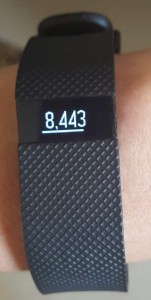 Recently one of my personal training clients came to me bragging about how he had walked over 35,000 steps in his regular work day and therefore didn’t need to do his cardio. I laughed and asked him if he even knew how those fitness trackers work? It tracks on the movement of your arm. Therefore, you can be washing dishes or changing a light bulb and it will be counting your arm movement as steps. According to a multiple studies, activity monitors may not be as accurate as you’d like them to be, with some of the most popular devices on the market getting it wrong at least 10 percent of the time.
Recently one of my personal training clients came to me bragging about how he had walked over 35,000 steps in his regular work day and therefore didn’t need to do his cardio. I laughed and asked him if he even knew how those fitness trackers work? It tracks on the movement of your arm. Therefore, you can be washing dishes or changing a light bulb and it will be counting your arm movement as steps. According to a multiple studies, activity monitors may not be as accurate as you’d like them to be, with some of the most popular devices on the market getting it wrong at least 10 percent of the time.
Overall Accuracy
The accuracy levels while resting are quite impressive. However, this is not the same when one is active.
Accuracy of the Heart Rate Measurement
Ones heart rate is measured by the expansion and contraction of blood vessels and their rhythm. LED lights on the tracker detect the changes in volume of blood being pumped. To get the heart rate, most fitness trackers use this simple formula – 220 subtract your age. This helps you to optimize on your exercise, bearing in mind the various intensities. This accuracy can be altered by many factors. The higher up your arm you place your tracker, the better the blood flow, thus it gives a more accurate reading. The wristband should not be too tight, as it will restrict the flow of blood leading to an inaccurate reading.
Reason for Extra Floor Readings
Most trackers count floors using an altimeter. This is an altitude sensor based on atmospheric pressure. Though the trackers are meant to measure change in pressure because of elevation, other reasons might cause a change in pressure like wind and opening of a door. This might cause the tracker accuracy to be distorted by adding a floor or two.
Reason for Extra Steps
When cooking, working at a desk, or other activities involving arm movements, trackers may think you are walking and can pick up extra steps.
Accuracy of Calories Burned
This is fairly accurate. Basal Metabolic Rate (BMR) is responsible for at least half the calories lost in a day. BMR is the rate at which the body burns calories during the normal functioning of the body like brain activity and breathing. BMR is measured according to weight, gender, height and age. If the tracker takes into account BMR when it is calculating lost calories.it may be a tad bit more accurate. The tracker also accounts for the calories lost because of the heart rate. At midnight, the tracker should automatically reset the calorie statistics and start over.
For more information on fitness trackers, how to burn fat, getting in shape, eating healthy, weight training, health and wellness, or if you’re frustrated with your current level of fitness and have been thinking about hiring a personal trainer, contact us.
5 Different Squats to Tighter Toned Glutes
5 Different Squats To Tighter Toned Glutes
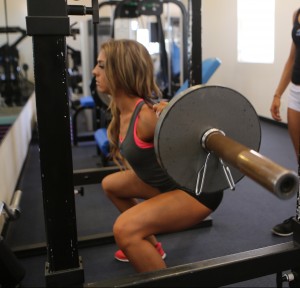 With summer approaching quicker than we’d like to think, it is time to start planning for our summer wardrobe. By this I mean shorts season, swimsuit shopping, aiming for those tighter, more shapely glutes!! These squats will work your glutes and leg muscles better than any amount of cardio! Not to mention they can be modified for beginners, or performed with a heavier weight to make them more difficult depending on your preference and fitness capabilities.
With summer approaching quicker than we’d like to think, it is time to start planning for our summer wardrobe. By this I mean shorts season, swimsuit shopping, aiming for those tighter, more shapely glutes!! These squats will work your glutes and leg muscles better than any amount of cardio! Not to mention they can be modified for beginners, or performed with a heavier weight to make them more difficult depending on your preference and fitness capabilities.
- Body Weight Squats
This is a regular squat with zero exercise equipment. There are no dumbbells or barbells involved. Get into basic squat form, feet shoulder width apart, feet slightly pointed out, squat down to where your knees reach a 90 degree angle and try to maintain the weight through your heels as you push yourself back up to start. Remember to maintain a flat back throughout the exercise and try not to slouch forward or lean back. - Plie Squats
In this squat your feet need to be wider than shoulder width apart with feet angled outward. Same rules apply of a regular squat apply to this one. Be sure to keep your back in line, chest up, and you are going to bend your knees more outward than straight. This is going to target your inner thighs significantly. To make it more difficult, grab some weights! - Sissy Squats Get into basic squat form, squat, and once you reach the bottom of the squat, instead of coming back up all the way only come half way up, keeping the tension in your quads, and then lower back down into the squat. Repeat this multiple times to “pulse”. You will really feel the burn with this one!
- Plyometric Squats or Jump Squats This type of squat will really increase your heart rate. Using the same form as a body weight squat, squat down, but when you get to the bottom of the squat, you are going to explode up and jump high.
- Barbell Squats
This type of squat is a pretty advanced exercise also known as the more traditional squat. Put the barbell on your shoulders, mostly resting on your trapezius muscle, the “traps”. This squat is done with normal squat form, but the reason it is more advanced is because it allows you to add a significant amount of weight. When doing this squat remember to find that comfortable foot stance, squat down to where your knees reach a 90 degree angle and try to maintain the weight through your heels as you push yourself back up to start. Remember to maintain a flat back throughout the exercise, keeping your chest up, and try not to slouch forward or lean back.
For more tips on obtaining tighter toned glutes, eating healthy, weight training, health and wellness, or if you’re frustrated with your current level of fitness and have been thinking about hiring a personal trainer, contact us.
Diet and Blood Pressure!
Diet and Blood Pressure!
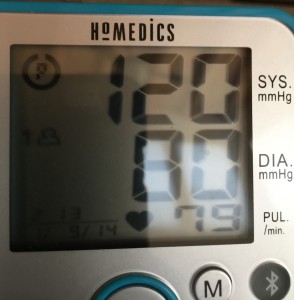 High blood pressure is a serious health concern among Americans. It affects more in the US each year. Over time, it causes blood vessel damage that can lead to heart disease, kidney disease, stroke, and other serious issues. Hypertension also known as the silent killer produces no symptoms. If you don’t get your blood pressure checked regularly, hypertension could go unnoticed, and untreated, for years. Exercise is a great way to manage your blood pressure. However, it is imperative to follow a healthy diet in addition to exercise and strength training. Because your diet plays such an important role in whether you have high or normal blood pressure readings, dietary recommendations for lowering blood pressure include reducing your intake of fat, sodium, and alcohol. Eating foods rich in potassium, calcium, and magnesium should make up a big part of your diet. In general, you should eat more low-fat protein sources, whole grains, and plenty of fruits and vegetables.
High blood pressure is a serious health concern among Americans. It affects more in the US each year. Over time, it causes blood vessel damage that can lead to heart disease, kidney disease, stroke, and other serious issues. Hypertension also known as the silent killer produces no symptoms. If you don’t get your blood pressure checked regularly, hypertension could go unnoticed, and untreated, for years. Exercise is a great way to manage your blood pressure. However, it is imperative to follow a healthy diet in addition to exercise and strength training. Because your diet plays such an important role in whether you have high or normal blood pressure readings, dietary recommendations for lowering blood pressure include reducing your intake of fat, sodium, and alcohol. Eating foods rich in potassium, calcium, and magnesium should make up a big part of your diet. In general, you should eat more low-fat protein sources, whole grains, and plenty of fruits and vegetables.
- Leafy Greens- Leafy greens like romaine lettuce, arugula, kale, turnip greens, collard greens, and spinach are high in potassium. Opt for fresh or frozen greens, as canned vegetables contain excess sodium.
- Berries-Blueberries, raspberries, and strawberries are easy to add to your diet. Berries are rich in natural compounds called flavonoids. Consuming these compounds may prevent hypertension, and possibly help to reduce high blood pressure.
- Potatoes-Potatoes are high in both potassium and magnesium, two minerals that can help to lower your blood pressure. They are also high in fiber, which is necessary for an overall healthy diet. Instead of topping this healthy choice with fattening and salty butter or sour cream, try adding plain yogurt or salsa for flavor.
- Low Fat Milk-Increase the amount of calcium-rich foods that consume. Low-fat milk is an excellent source of calcium. Calcium is another important element of a diet for lowering blood pressure. If you don’t care for milk, substitute low-fat or non-fat yogurt. Just beware of those that are high in sugar.
- Oatmeal-High-fiber, low-fat, and low-sodium foods are ideal for lowering your blood pressure, and oatmeal fits that bill. Oatmeal is a great way to begin your day, for it is a slow digesting complex carb full of fiber.
For more information on managing your blood pressure through diet and exercise, looking to get in shape, live a healthier lifestyle, or if you’re frustrated with your current level of fitness and thinking about hiring a personal trainer, contact us.
3 Tips For Muscle Recovery
3 Tips For Muscle Recovery
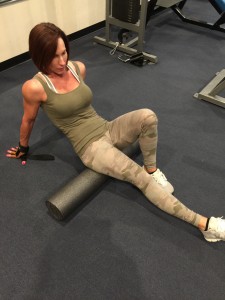 When you drive your car, you know the amount of monthly maintenance involved in making your car run smoothly. Regular oil changes, rotation of the tires, regular tune ups. But when it comes to the body, most people tend to drive their bodies hard and forget about the monthly maintenance involved in making their bodies run smoothly. You likely enjoy going to the gym and breaking your muscle fibers down, but are you allowing enough time for your muscles to rebuild? It is what you do outside of the gym and in between workouts that allow for your muscles to recover which maximizes the strength-building goals you are working so hard to achieve. What you do on off-days is just as crucial as what you do in the gym.
When you drive your car, you know the amount of monthly maintenance involved in making your car run smoothly. Regular oil changes, rotation of the tires, regular tune ups. But when it comes to the body, most people tend to drive their bodies hard and forget about the monthly maintenance involved in making their bodies run smoothly. You likely enjoy going to the gym and breaking your muscle fibers down, but are you allowing enough time for your muscles to rebuild? It is what you do outside of the gym and in between workouts that allow for your muscles to recover which maximizes the strength-building goals you are working so hard to achieve. What you do on off-days is just as crucial as what you do in the gym.
Isometrics Should Be Incorporated With High Intensity Workouts
On a rest day, trade in your high-power weight lifting exercises for Isometrics: gentle stretching and holding a certain position for a period of time, your muscles are still engaged, but at a lower intensity. This allows nutrient rich blood to circulate through the muscles in order to enhance recovery and help them rebuild for your next intense training session.
Promote Circulation
Even on your rest day, stay nimble by moving your joints and muscles. The opening and closing of your joints brings fresh synovial fluids to lubricate, nourish, and hydrate these areas, while expelling waste and scar tissue. Rotate clockwise and counterclockwise to prevent imbalances and overuse injuries. Don’t forget to drink that water! Stay hydrated in order to flush the toxins from your body!
Invest In A Foam Roller
If you’re feeling tightness or soreness post-workout, you can use a long, semi-soft foam roller tube to give your muscles a massage. Using a foam roller breaks up scar tissue and any knots in the fascia. It is important to take care of this, for if they are left unattended it can lead to nagging aches and pains in your joints. If you spend at least 30-60 seconds minimum rolling sore muscle groups before bed and any time you can spare throughout the day this will assist in the muscle recovery process.
For more tips on muscle recovery, getting in shape, eating healthy, weight training, health and wellness, or if you’re frustrated with your current level of fitness and have been thinking about hiring a personal trainer, contact us.
Personal Trainer Albuquerque(Why You Need One)
Personal Trainer Albuquerque(Why You Need One)
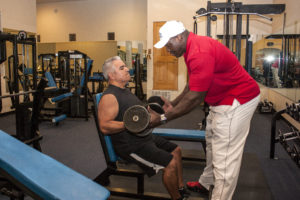 Why do you need a personal trainer in albuquerque you ask? If you were visiting a state or a country you had never been to before, would you hire a tour guide? If you were confused about a certain subject in school like chemistry or math, would you hire a tutor? The same concept holds true about the gym and your body.
Why do you need a personal trainer in albuquerque you ask? If you were visiting a state or a country you had never been to before, would you hire a tour guide? If you were confused about a certain subject in school like chemistry or math, would you hire a tutor? The same concept holds true about the gym and your body.
Why You Need A Personal Trainer
A personal trainer’s job is to help you to understand how to do certain exercises properly. They motivate you to push those extra few reps, and to educate you on what you may or may not be doing that is preventing you from reaching your fitness goals. Still, there are individuals who shy away from seeking the expertise of a personal trainer in albuquerque. Perhaps unsure of what they’ll get from the experience or whether it’s worth the money. There are a number of reasons why people looking to get in shape should hire a personal trainer. Here are just a few of them.
1. You Don’t Know Where To Begin
Knowing how to set up a routine that incorporates all the activities you need to do such as cardio, strength training, body fat testing can be a bit overwhelming. Not to mention the amount of time that should be dedicated to doing these activities. Or the time dedicated to choosing the exercises that would be most beneficial for your body type, which weights to use, number of reps, and number of sets. This is where a personal trainer can be invaluable. He can help you maximize your time while keeping you within your limits so you don’t overdo it and become over-trained or worse, injure yourself. He can also help you set goals and create specific schedules so you know when, how and where you’ll fit in your workouts to see the maximum results.
2. You’re Not Seeing Results
If you’ve been working out consistently for several weeks, months, or even years and aren’t seeing the results you want or even progress towards those goals you set hiring a personal trainer in albuquerque may be what you need. A trainer can assess your current program and eating habits and help you see where you could make changes to create more effective workouts. A trainer can ensure the goals you’ve set are realistic for you, hold you accountable for your workouts and help you stay motivated. You may even find that you are seeing results, just not in the way you expected, take advantage of the expertise a personal trainer can provide.
3. You’re Bored With Your Current Routine
A trainer can bring a fresh perspective and new ideas to challenge both your body and your mind. A trainer can motivate you to push past those self-imposed limits, encouraging you to get in those few extra reps, go longer and challenge yourself more than you would on your own. You’ll find it’s very hard to slack off with a trainer standing over you, telling you to do just…one…more…rep! You may even find hidden strengths you never knew you had, which can motivate you even more.
4. You Want motivation And Support During Your Workouts
Some people know how to exercise and they even know how to do the exercises with proper form, but they like having a trainer around for support and motivation. If you’re lifting very heavy weights and need a spot, working with a personal trainer in albuquerque might be a good choice for you.
If any of the above apply to you, you are looking to get in shape, or you’ve been thinking about hiring a personal trainer, contact us.

